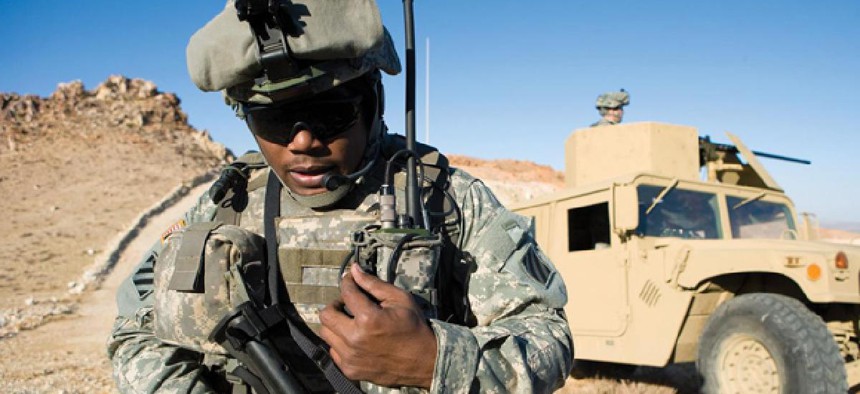Pentagon shutters Joint Tactical Radio System program office

Harris Corporation/AP
After 15 years and $15 billion, the program failed to deliver radios to the battlefield.
After struggling for 15 years to develop a software-based radio for all four services at a cost of $15 billion, the Pentagon quietly shut down the Joint Tactical Radio System program office earlier this month and transferred its acquisition functions to the Army.
Frank Kendall, undersecretary of Defense for acquisition, technology and logistics, disbanded the San Diego-based JTRS Program Executive Office effective Sept. 30 and authorized establishment of the Army-run Joint Tactical Networking Center, which will manage JTRS radio acquisition, Pentagon spokeswoman Cheryl Irwin said. The move was first reported by Inside Defense last week.
The Pentagon launched the JTRS program in 1997; it’s an ambitious effort to use software to control radio functions -- such as frequency, bandwidth, modulation and security -- previously baked into the hardware.
This approach, in theory, would allow the Defense Department to build a family of radios with a common software core capable of handling functions split among separate hardware-based radios -- VHF voice radios for infantry units; UHF voice radios for air-to-air and ground-to-air communications; long-range HF radios for ships and ground troops; and a wideband radio capable of transmitting data at megabit speeds across a battlefield.
Commonality would reduce the number of radios all four services use from 750,000 to slightly more than 300,000 and for specialized units, such as Marine Forward Air Control teams, shrink the number of radios those teams carry from three to one.
Development problems delayed fielding of JTRS radios into a realistic test environment until 2010 when the Army started evaluating them at White Sands Missile Range, N.M. The 207-pound refrigerator-size Ground Mobile Radio that Boeing developed lacked refrigeration and had a difficult time withstanding desert heat, soldiers reported.
J. Michael Gilmore, Defense's director of operational test and evaluation, told a House Armed Services Committee hearing in March 2001 that the Boeing radio had a 72 percent failure rate, forcing the Army to rely on runners for communications, something the service “has not done since World War II.”
Kendall canceled the Boeing JTRS radio program in October 2011 rather than spend another $15 billion to acquire radios that did not work.
Soldiers at White Sands also complained about the long time it took to boot up the JTRS backpack -- 1 minute -- an eternity in combat.
Since JTRS could not field radios to units engaged in combat operations in Iraq and Afghanistan, the services spent $11 billion during the past decade to acquire commercial radios, according to an article in the July issue of National Defense magazine by Air Force acquisition office Lt. Col. Dan Ward, currently serving in Afghanistan.
This total includes $3.1 billion in contracts to ITT for VHF Single Channel Ground and Airborne Radio Systems with more than 500,000 of those radios fielded as the JTRS program foundered.
Both Harris Corp. and Thales Communications have benefitted from delays in fielding of JTRS radios, with the Special Operations Command awarding the two companies contracts for handheld and backpack radios in April.
Kendall tacitly endorsed the JTRS Rifleman Radio and gave the Army the go-ahead to buy for infantry squads 13,000 of the radios produced by Thales and General Dynamics, Irwin said.
Irwin said JTRS software is now at the stage where it has “fostered the emergence of competitive markets to deliver radios to meet service requirements.”
NEXT STORY: Networx transition deemed nearly complete



